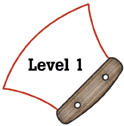 |
Mini-Unit:
Nature Trails
Performance Standard
A12, Level 1
Students sort plants and animals into groups using consistent criteria
and describe how some characteristics are for the survival of the
plant or animal.
|
 |

Key Concepts and
Skills
|
- There are similarities and differences in plants.
- Plants are classified by different attributes.
- Students can use the processes of science including observation,
classification, and communication.
|
 |

Timeline
|
2 weeks or longer.
|
 |

Abstract
|
This unit focuses on skills of observation and classification
that need to take place over and over again in a child’s
primary education. After observing, collecting, and classifying
plants found along nature trails, Students will communicate their
findings with their classmates and teacher. Before this mini-unit
takes place, students should have previous experiences with sorting
and classifying.
|
 |

Materials
|
- Science journal
- Hand lens
- Small plastic bag
- Clip board
- Chart paper
- Pencils, colored pencils, markers
|
 |

Activities
|
1
Class will take a nature walk. Prior to going on the walk, students
draw what they think they will see, hear, touch, or smell on their
walk. Back in the classroom after the walk, students draw what
they did see, hear, touch, or smell during the walk. They share
their favorite thing drawn and put it on chart paper. Hang in
classroom.
Embedded Assessment
Teacher checks the student’s science journals when back
in the classroom.
2
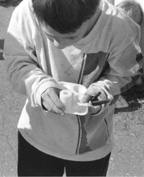 Go
on a sound walk. Listen for man-made sounds. Create a sound map
in their science journal by doing the following activity. Each
student finds a place to sit or stand where they are not looking
at anyone else. Sit quietly for 2–3 minutes. In their science
journal mark with an “X” where sound came from in relation
to self (in front of, in back of, right, left, above). Then talk
about which sounds were heard and where. Do the same sound activity
again for 2 minutes. Discuss again. Go
on a sound walk. Listen for man-made sounds. Create a sound map
in their science journal by doing the following activity. Each
student finds a place to sit or stand where they are not looking
at anyone else. Sit quietly for 2–3 minutes. In their science
journal mark with an “X” where sound came from in relation
to self (in front of, in back of, right, left, above). Then talk
about which sounds were heard and where. Do the same sound activity
again for 2 minutes. Discuss again.
3
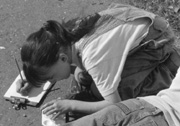 Go
on a sight walk outside. Ask a knowledgeable adult to accompany
students and help identify plants, animals, and so on. (Try to
include a scientist and an Elder knowledgeable in natural uses
of plants.) Look for natural things. Do the following camera activity
with a partner. One student is the camera, one student is the
photographer. The photographer guides the camera (who has kept
eyes closed), to the object(s) that the observer wants the camera
to focus on. The photographer taps the camera’s shoulder,
which is the signal for the camera to open its lens (eyes) for
a count of ten. Then the camera closes its lens and the pair take
2–3 more pictures. After the pictures are taken, the camera
chooses one of the objects focused on and draws a picture with
as much detail as possible. Partners switch roles. After both
partners are done, find the area the picture was drawn from and
observe how much they remembered. Back in the classroom use, pictures
for a sorting activity. Go
on a sight walk outside. Ask a knowledgeable adult to accompany
students and help identify plants, animals, and so on. (Try to
include a scientist and an Elder knowledgeable in natural uses
of plants.) Look for natural things. Do the following camera activity
with a partner. One student is the camera, one student is the
photographer. The photographer guides the camera (who has kept
eyes closed), to the object(s) that the observer wants the camera
to focus on. The photographer taps the camera’s shoulder,
which is the signal for the camera to open its lens (eyes) for
a count of ten. Then the camera closes its lens and the pair take
2–3 more pictures. After the pictures are taken, the camera
chooses one of the objects focused on and draws a picture with
as much detail as possible. Partners switch roles. After both
partners are done, find the area the picture was drawn from and
observe how much they remembered. Back in the classroom use, pictures
for a sorting activity.
|
 |

Expanded Sample
Assessment Idea
|
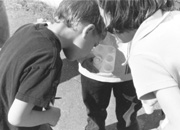 Students
will take a nature walk; observe plant and animal life; collect
samples of local plants. Students
will take a nature walk; observe plant and animal life; collect
samples of local plants.
Procedure
Students will:
- Discuss acceptable ways to collect plants before walk.
- Form student pairs; go on a walk accompanied by a knowledgeable
adult who will help identify plants and animals.
- Take a plastic bag with them and collect at least three,
but not more than five, different plants.
- Draw and label a picture of each plant collected in their
science journal. Write the plant’s native or familiar name.
- Work with another pair of students (now each group of four
has at least six to ten plants) sort the plant samples based
upon the group’s chosen criteria. (This process repeats
with groups of eight, and so on until the whole group is together.)
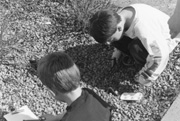 Reflection
and Revision Reflection
and Revision
What additional ways could you sort and classify the plants
that you observed? What special characteristics do some plants
have that others do not? What special characteristic helps each
plant to survive in its environment?
Level of Performance
|
|
|
Student work is complete, and shows evidence of logical
reasoning. Student collects and classifies four or five plants using
three or more attributes (color, size, shape, use, and so on). Drawings
are correctly labeled, and show correct color, size, and shape for
each plant that was collected and classified. Student shows several
ways that plants can be organized (in addition to the sorting criteria
used in class), and describe several examples of plant adaptation. |
|
|
Student work is complete, but may contain minor errors
or omissions. Student collects and classifies three plants using three
or more attributes (color, size, shape, use, and so on). Drawings
are labeled, and show color, size, and shape for several of the plants
that were collected and classified. Student describes one way that
plants can be organized (in addition to the sorting criteria used
in class), and describe at least one plant adaptation. |
Stage 2

 |
Student work is incomplete or incorrect. Student collects
at least two plants and attempts to classify them using some plant
attributes (color, size, shape, use, and so on). Drawings show color,
size, or shape for one plant that was collected. Student may attempt
to describe how to organize plants using a new attribute or may repeat
a description of the method used in class. Descriptions of plants
and plant adaptations may include misconceptions. |
Stage 1
 |
Student work is largely incomplete and incorrect.
|
 |

Standards Cross-Reference
(Alaska
Department of Education & Early Development Standards)
|
National Science
Education Standards
Each plant or animal has different structures that serve different
functions in growth, survival, and reproduction. For example,
humans have distinct body structures for walking, holding, seeing,
and talking. (Page 129)
Plants and animals have life cycles that include being born,
developing into adults, reproducing, and eventually dying. The
details of this life cycle are different for different organisms.
(Page 129)
Benchmarks
Some animals and plants are alike in the way they look and in
the things they do, and others are very different from one another.
(Page 102)
Plants and animals have features that help them live in different
environments. (Page 102)
Stories sometimes give plants and animals attributes they really
do not have. (Page 102)
|
|
|
Alaska Science Content
Standard Key Element
A
student who meets the content standard should distinguish the patterns
of similarity and differences in the living world in order to understand
the diversity of life and understand the theories that describe the importance
of diversity for species and ecosystems.
Cross-Reference
Additional
Content and Performance Standards: B1, B4, Math C1, Cultural Standards
A5, D2
|





 Go
on a sound walk. Listen for man-made sounds. Create a sound map
in their science journal by doing the following activity. Each
student finds a place to sit or stand where they are not looking
at anyone else. Sit quietly for 2–3 minutes. In their science
journal mark with an “X” where sound came from in relation
to self (in front of, in back of, right, left, above). Then talk
about which sounds were heard and where. Do the same sound activity
again for 2 minutes. Discuss again.
Go
on a sound walk. Listen for man-made sounds. Create a sound map
in their science journal by doing the following activity. Each
student finds a place to sit or stand where they are not looking
at anyone else. Sit quietly for 2–3 minutes. In their science
journal mark with an “X” where sound came from in relation
to self (in front of, in back of, right, left, above). Then talk
about which sounds were heard and where. Do the same sound activity
again for 2 minutes. Discuss again. Go
on a sight walk outside. Ask a knowledgeable adult to accompany
students and help identify plants, animals, and so on. (Try to
include a scientist and an Elder knowledgeable in natural uses
of plants.) Look for natural things. Do the following camera activity
with a partner. One student is the camera, one student is the
photographer. The photographer guides the camera (who has kept
eyes closed), to the object(s) that the observer wants the camera
to focus on. The photographer taps the camera’s shoulder,
which is the signal for the camera to open its lens (eyes) for
a count of ten. Then the camera closes its lens and the pair take
2–3 more pictures. After the pictures are taken, the camera
chooses one of the objects focused on and draws a picture with
as much detail as possible. Partners switch roles. After both
partners are done, find the area the picture was drawn from and
observe how much they remembered. Back in the classroom use, pictures
for a sorting activity.
Go
on a sight walk outside. Ask a knowledgeable adult to accompany
students and help identify plants, animals, and so on. (Try to
include a scientist and an Elder knowledgeable in natural uses
of plants.) Look for natural things. Do the following camera activity
with a partner. One student is the camera, one student is the
photographer. The photographer guides the camera (who has kept
eyes closed), to the object(s) that the observer wants the camera
to focus on. The photographer taps the camera’s shoulder,
which is the signal for the camera to open its lens (eyes) for
a count of ten. Then the camera closes its lens and the pair take
2–3 more pictures. After the pictures are taken, the camera
chooses one of the objects focused on and draws a picture with
as much detail as possible. Partners switch roles. After both
partners are done, find the area the picture was drawn from and
observe how much they remembered. Back in the classroom use, pictures
for a sorting activity. Students
will take a nature walk; observe plant and animal life; collect
samples of local plants.
Students
will take a nature walk; observe plant and animal life; collect
samples of local plants. Reflection
and Revision
Reflection
and Revision